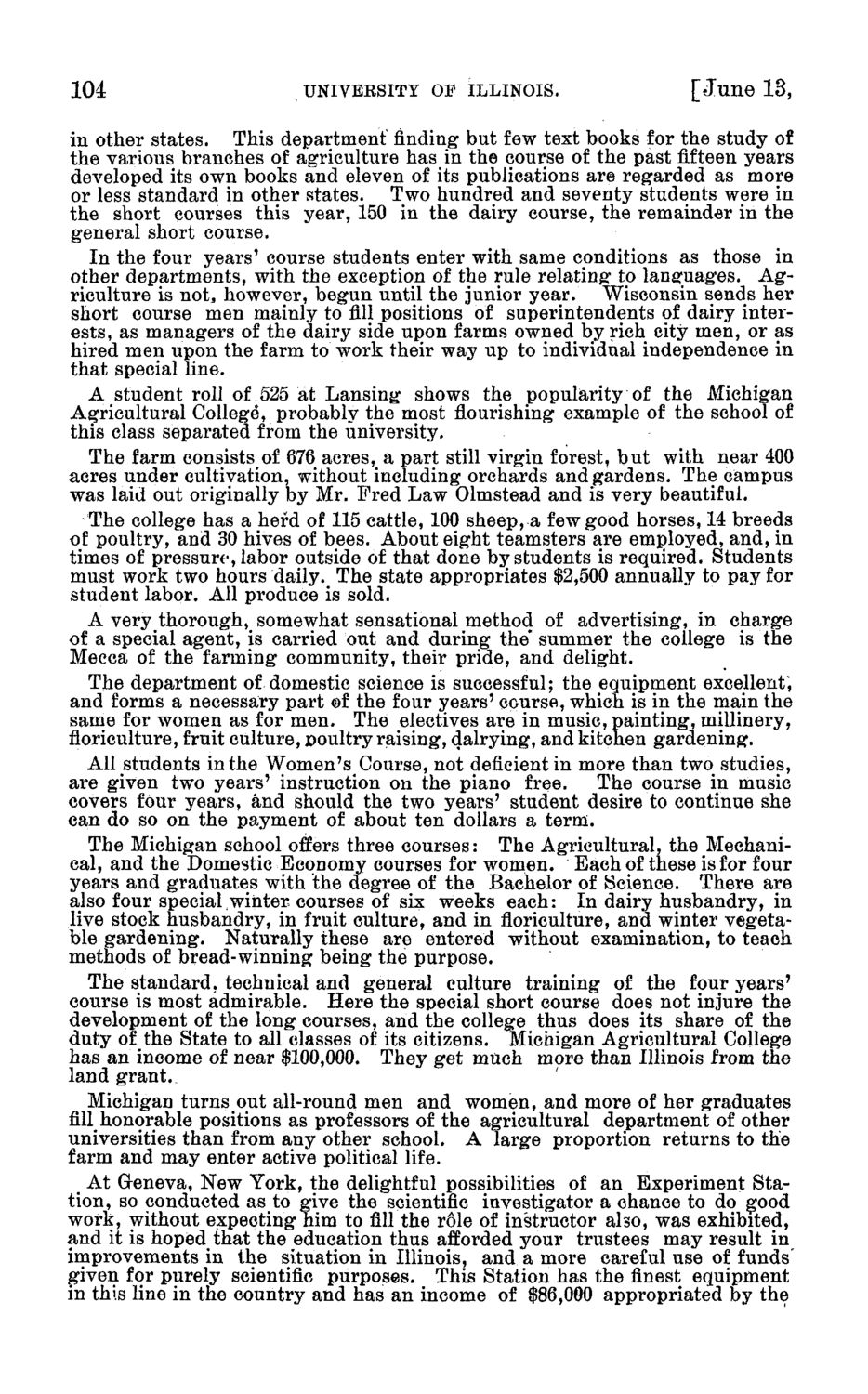| |
| |
Caption: Board of Trustees Minutes - 1900
This is a reduced-resolution page image for fast online browsing.

EXTRACTED TEXT FROM PAGE:
104 UNIVERSITY OF ILLINOIS. [ J u n e 13, in other states. This department finding but few text books for the study of the various branches of agriculture has in the course of the past fifteen years developed its own books and eleven of its publications are regarded as more or less standard in other states. Two hundred and seventy students were in the short courses this year, 150 in the dairy course, the remainder in the general short course. In the four years' course students enter with same conditions as those in other departments, with the exception of the rule relating to languages. Agriculture is not, however, begun until the junior year. Wisconsin sends her short course men mainly to fill positions of superintendents of dairy interests, as managers of the dairy side upon farms owned by rich city men, or as hired men upon the farm to work their way up to individual independence in that special line. A student roll of 525 at Lansing shows the popularity of the Michigan Agricultural College, probably the most flourishing example of the school of this class separated from the university. The farm consists of 676 acres, a part still virgin forest, but with near 400 acres under cultivation, without including orchards and gardens. The campus was laid out originally by Mr. Fred Law Olmstead and is very beautiful. The college has a herd of 115 cattle, 100 sheep, a few good horses, 14 breeds of poultry, and 30 hives of bees. About eight teamsters are employed, and, in times of pressure', labor outside of that done by students is required. Students must work two hours daily. The state appropriates $2,500 annually to pay for student labor. All produce is sold. A very thorough, somewhat sensational method of advertising, in charge of a special agent, is carried out and during the* summer the college is the Mecca of the farming community, their pride, and delight. The department of domestic science is successful; the equipment excellent; and forms a necessary part of the four years' course, which is in the main the same for women as for men. The electives are in music, painting, millinery, floriculture, fruit culture, poultry raising, dairying, and kitchen gardening. All students in the Women's Course, not deficient in more than two studies, are given two years' instruction on the piano free. The course in music covers four years, and should the two years' student desire to continue she can do so on the payment of about ten dollars a term. The Michigan school offers three courses: The Agricultural, the Mechanical, and the Domestic Economy courses for women. Each of these is for four years and graduates with the degree of the Bachelor of Science. There are also four special winter courses of six weeks each: In dairy husbandry, in live stock husbandry, in fruit culture, and in floriculture, and winter vegetable gardening. Naturally these are entered without examination, to teach methods of bread-winning being the purpose. The standard, techuical and general culture training of the four years' course is most admirable. Here the special short course does not injure the development of the long courses, and the college thus does its share of the duty of the State to all classes of its citizens. Michigan Agricultural College has an income of near $100,000. They get much more than Illinois from the land grant. Michigan turns out all-round men and women, and more of her graduates fill honorable positions as professors of the agricultural department of other universities than from any other school. A large proportion returns to the farm and may enter active political life. At Geneva, New York, the delightful possibilities of an Experiment Station, so conducted as to give the scientific investigator a chance to do good work, without expecting him to fill the r61e of instructor also, was exhibited, and it is hoped that the education thus afforded your trustees may result in improvements in the situation in Illinois, and a more careful use of funds' given for purely scientific purposes. This Station has the finest equipment in this line in the country and has an income of $86,000 appropriated by the
| |